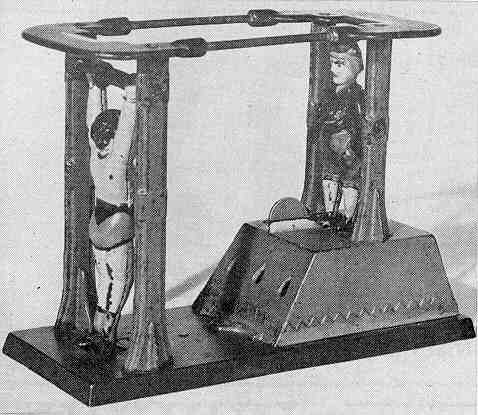Acrobat Bank
by F.H. Griffith - HOBBIES Magazine - September, 1958

A mechanical bank with unusual action is our choice as No. 67 in the numerical classification of mechanical banks. This bank, the Acrobat Bank, does have unique operation principles, however, there are two other mechanical banks that would fit into the same category. One, the Clown On Bar, is quite rare, and the other, the Boy on the Trapeze, is more or less common on a comparative basis. These two banks employ the weight of a coin in their respective operation while the Acrobat Bank is entirely different in its operation principle with the weight of the coin having nothing whatsoever to do with the action.
The Acrobat Bank was manufactured by the J. & E. Stevens Company of Cromwell, Connecticut. It was patented April 3, 1883 by Edward L. Morris of Boston, Massachusetts. In the patent papers he refers to the bank as the Gymnast Bank or the Bar Performer Bank. Actually Bar Performer is a more accurate name for the bank, however, it was listed for sale in old Stevens catalogs of the period as the Gymnast Bank. Some of the bank collectors have in more recent years called the bank Two Men On Trapeze, however, the more generally accepted name up to date has been the Acrobat Bank and this seems appropriate enough. It might be well to point out that if the terminology Bar Performer were used as the name of this bank then there would be definite confusion between it, the Clown On Bar, and the Boy On The Trapeze.
The bank shown was obtained by the writer some years ago in New England. It is in excellent original condition with good paint, particularly for this bank. The colors are as follows: The base is dark brown and the four supporting posts are red. The section on top of the posts is blue with white decorations and the platform on which the clown is standing is gray with red outlining at the bottom. The figure of the clown has a red hat and red trousers, a blue shirt and white stockings. The gymnast has red shoes and his red trunks are outlined in blue with a black sash type belt. The rest of the figure is a natural skin color and he has black hair and a very impressive black handlebar type moustache. It is possible that the figure is represented as wearing tights as there is a blue collar-like representation around his neck and a blue line at each wrist.
The bank is pictured ready for operation with the coin in the proper position. The lever to operate is located on the base under the toes of the gymnast. When the lever is pressed the gymnast swings forward and around on the bar and ends up actually standing on his hands. In the process the gymnast’s toes hit a protruding section on the clown’s shirt, this causes the clown to revolve between the uprights and he ends up standing on his head. The head of the clown contacts a lever located on the platform. Upon contact the lever moves to the side allowing the coin to drop into the bank. To reset the bank the gymnast is first replaced in position and then the clown is turned over to the position shown.
The Acrobat Bank is rather difficult to find in good original condition with no repairs. The operation of the spring arrangement on the gymnast’s hands plus the impact when kicking the clown over subjects the arms of the gymnast’s figure to severe strain and the bank is often found broken at this point. The interesting action of the bank makes it especially desirable to have in a collection.
